Police on Sunday are resuming efforts to clear the Ambassador Bridge, the key trade route that links Windsor, Ont., and Detroit, where protesters opposed to COVID-19 public health restrictions have brought traffic to a standstill for days.
Windsor Police say enforcement actions are under way at the foot of the bridge, saying they’re towing vehicles still at the protest site and barring anyone else from arriving on scene. The bridge is not yet open to traffic.
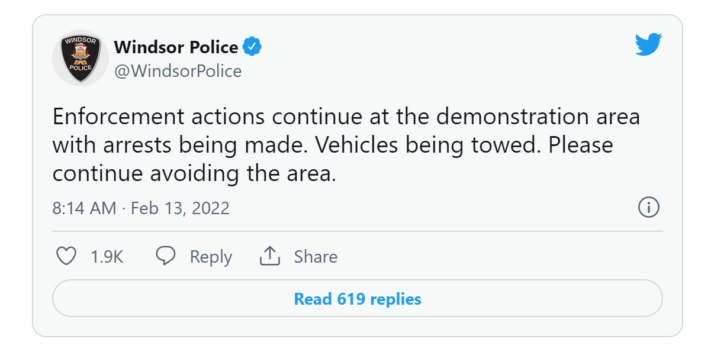
Protests against COVID-19 restrictions had continued across the country on Saturday and several Canada-U.S. border crossings remained closed due to blockades set up by demonstrators demanding that all pandemic measures be lifted immediately.
In Ottawa, hundreds of demonstrators and dozens of trucks and vehicles continued to effectively shut down the city’s downtown core as the protest there entered its third week, with people continuing to settle in for the long term by erecting a large stage by Parliament Hill. Trucks continued to honk their horns and rev their engines as they blocked major roads in the city’s centre.
Ottawa police, which have been criticized for allowing the protest to continue for so long, said they have a plan to resolve the situation and are awaiting more reinforcements.
They said they’ve created an “integrated command centre” to respond to the convoy protest downtown. They added that the centre will help the force co-ordinate with OPP and RCMP, and will lead to an “enhanced ability” to “respond to the current situation.”
Police also said they struggled with enforcement today because there were more than 4,000 protesters present and some engaged in “aggressive, illegal behaviour.”
“The Ottawa Police Service continues to deploy all available resources to put an end to the unlawful demonstration in the downtown core, respond to calls for service, and improve neighbourhood safety,” read a statement from the police force.
“Overnight, demonstrators exhibited aggressive behaviour towards law enforcement including refusing to follow directions, overwhelming officers, and otherwise subverting enforcement efforts.”
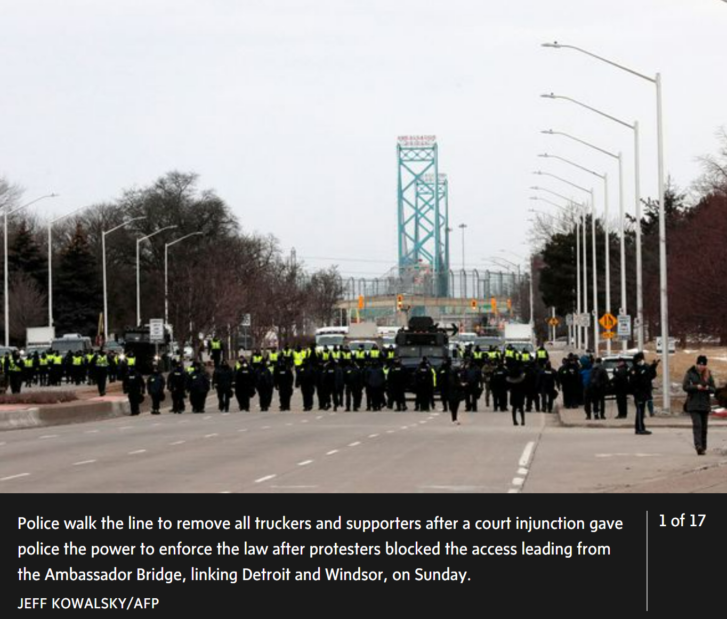
On Saturday night, Prime Minister Justin Trudeau posted to Twitter that he had convened a meeting with an “incident response group” of cabinet ministers and other senior government officials to discuss “the efforts underway to address the illegal blockades and occupations.”
In a readout from the meeting, his office said the group “discussed further immediate actions” the government is considering, and will reconvene Sunday.

On Saturday, people tore down a fence that had been set up to protect the National War Memorial after protesters used the monument as a toilet and stood atop the Tomb of the Unknown Soldier when the demonstrations first began.
Meanwhile, Ottawa police said counter-protesters were marching at a site away from the downtown occupation, and said no clashes between the groups had been reported as of Saturday afternoon.
Videos posted on social media showed hundreds of counter-protesters holding signs and chanting “Whose streets? Our streets,” among other slogans.
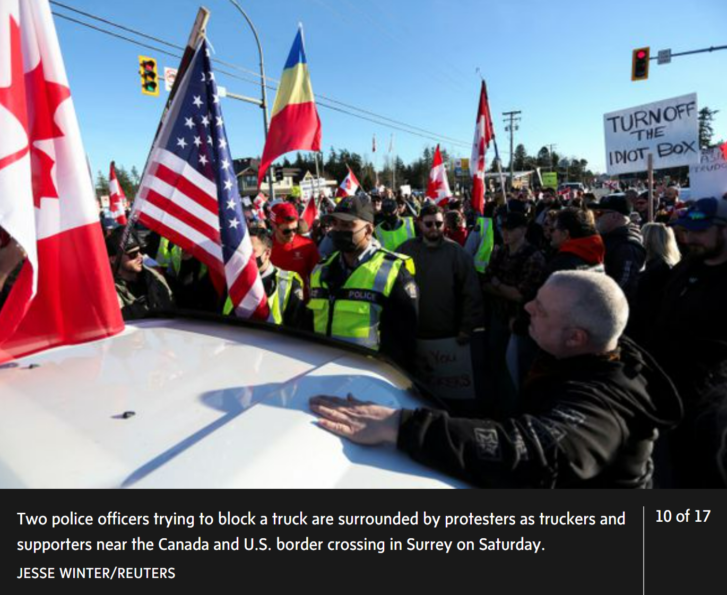
In B.C., the main route to the Pacific Highway border crossing to Washington in Surrey closed Saturday evening after protesters opposed to COVID-19 measures broke through RCMP barricades and began driving the wrong way down 176 Street.
RCMP Sgt. Maureen Hickey confirmed no arrests have yet been made.
The Canada Border Services Agency said that while that border is still open, travellers should use “an alternative processing site” until the road clears.
Hundreds of protesters also returned to Toronto on Saturday, after police successfully blocked roads and prevented people from establishing a permanent presence around the Ontario legislature building last weekend.
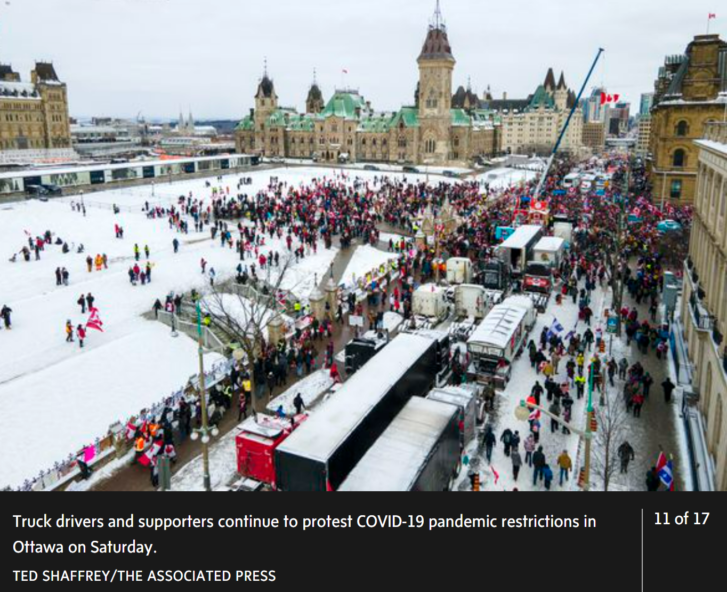
Members of the crowd cheered and waved flags during one speech that declared the protest was about freedom.
Ontario declared a state of emergency on Friday to allow for more police powers and stiff penalties for protesters, and a judge approved an injunction against a protest blocking the Ambassador Bridge. The injunction was sought by lawyers for the City of Windsor and the auto industry who said the blockades forced the shutdown of auto plants and local schools.
The blockage has put a stop to approximately $300-million in daily cross-border trade that passes across the Ambassador Bridge – Canada’s most important trade artery with the U.S.

“The free flow of trade is critical to our economy and blockades will not be tolerated,” Premier Doug Ford tweeted on Saturday. “We’re going to move forward as quickly as we can to clear the #AmbassadorBridge and get people’s lives back to normal in @CityofOttawa.”
Mr. Ford also said that the province was on track to “very soon” remove almost all restrictions for businesses as part of Ontario’s reopening plan.
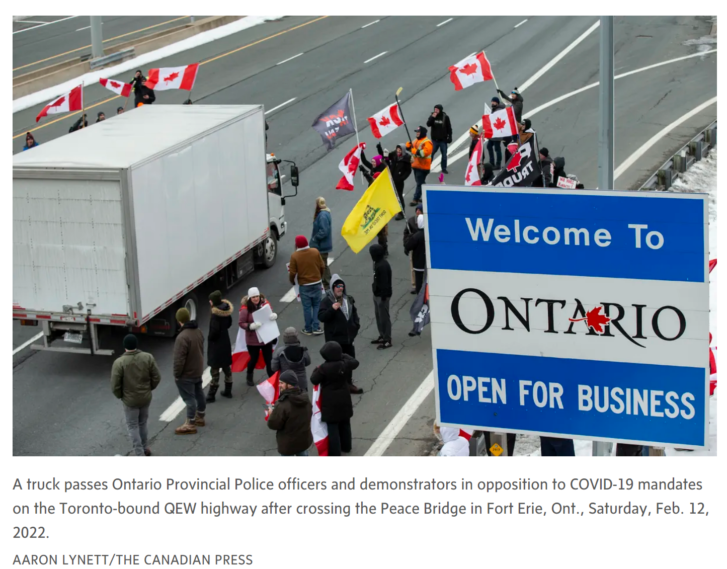
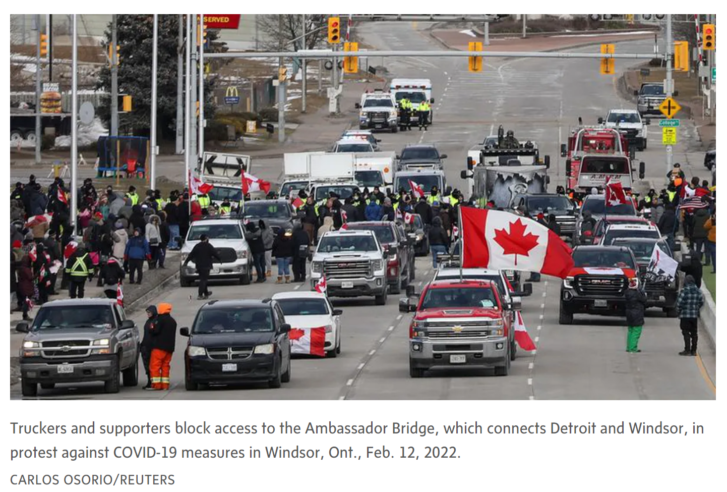
On Saturday morning, Windsor police, supported by provincial police and other regional police agencies, pushed protesters away from the bridge, but the border crossing remained closed.
Police forces in other parts of Ontario were working pre-emptively to prevent similar closures at critical border crossings.
In Fort Erie, Ont., Niagara Regional Police said they shut down a section of highway heading towards the Peace Bridge crossing after a convoy was spotted heading to the bridge Saturday morning.
Constable Philip Gavin said commercial and civilian traffic was still able to cross the Peace Bridge if vehicles were able to access border on-ramps through other roads.
And in Eastern Ontario, Cornwall police warned of traffic delays after multiple tractors and personal vehicles arrived at the Seaway International Bridge, but said traffic was still able to cross the border as of the afternoon.
“The Cornwall Police Service has mobilized our policing resources to ensure public safety, while maintaining peace, order and security,” said Police Chief Shawna Spowart in a statement. “I want to assure the residents of Cornwall, Akwesasne and Stormont, Dundas & Glengarry, that we are working closely with our law enforcement partners to minimize disruption to our communities and that any acts of violence or unlawful activities will not be tolerated.”
Further west, the shutdown of the Coutts, Alta., border crossing entered its third week Saturday, and RCMP in Manitoba said a group of semi-trailers, farm equipment and passenger vehicles were still blocking almost all traffic across the border, aside from emergency vehicles and agriculture transport.
“There was an initial estimate of 50 vehicles at the establishment of the blockade,” read a statement from the RCMP.
“As of … February 12, 2022, the number of vehicles participating in the blockade has remained largely unchanged. This number continues to fluctuate as vehicles arrive and depart the blockade.”
In Victoria, police warned residents of traffic disruptions as protesters drove laps around the provincial legislature in their cars, as others on foot lined the streets.
The protests began last month as a truck convoy following cross-border vaccine mandates, but have since morphed into a much larger movement demanding the end of all COVID-19 restrictions.

